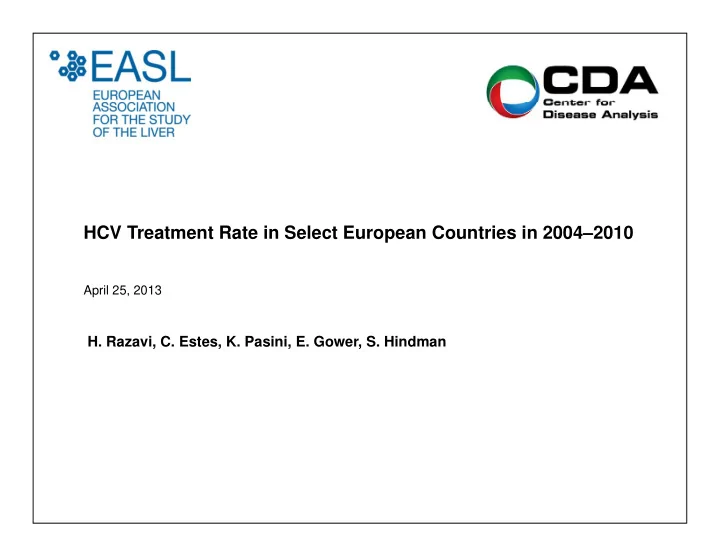

HCV Treatment Rate in Select European Countries in 2004–2010 April 25, 2013 H. Razavi, C. Estes, K. Pasini, E. Gower, S. Hindman
Disclosure: • The Center for Disease Analysis has received funding or grants from AbbVie, Boehringer Ingelheim, Gilead, Merck, Novartis, and Vertex • The funding for this work was provided by the Center for Disease Analysis 2
Background • The emergence of new direct acting antiviral (DAA) therapies will, most likely, lead to increase in the number of treated HCV patients. • However, there is a lack of historical data on the number of patients treated. H th i l k f hi t i l d t th b f ti t t t d • Objective: Quantify the number of patients treated and the treatment rate for 22 European countries: North & Western Southern Europe Eastern Europe » Austria » Greece » Czech Republic » Belgium » Italy » Hungary » Denmark » Portugal » Poland » Finland » Spain » Romania » France » Russia » » Germany Germany » » Slovakia Slovakia » Ireland » Netherlands » Norway » Sweden » Switzerland » UK 3
Methodology • The study was limited to 22 European countries where reliable data was available. • The annual number of pegylated interferon (alpha & beta) units sold was gathered by country. • The number of units were adjusted for: » Uses in non-HCV indications – including treatment of hepatitis B virus (HBV) infection. » Under-reporting – used comparisons of sales channels (hospital and retail) and national data reporting total treated population. • The average number of units per patient per year was calculated based upon: » Country-specific genotype distributions » Average duration of treatment by genotype » Average Peg/Riba therapy persistence • The annual number of treated patients was estimated using the adjusted units sold and the average number of units per patient per year. g p p p y 4
Example: France 15% of Pts 56% of Pts 29% of Pts are are G1 are G2/3 G4/Other 48 Weeks 24 Weeks 48 Weeks of o o of o of Treatment Treatment Treatment Average # Average # 439,200 of Weeks Units Sold per Pt 41.0 Use in HBV Use in HBV (-10%) Units per Persistence Patient 85% 34.9 11,325 Patients Treated 5
Total Number of Viremic HCV Cases – 2010 (000) 2,500 (000) ases in 2010 ( 2,100 2 100 2,000 1 500 1,500 remic HCV Ca 1,500 1,000 1 000 Number of Vir 600 540 450 500 Total N 230 210 190 120 120 120 70 70 50 40 40 40 30 30 20 10 20 0 Alberti A, Negro F, The global burden of hepatitis C virus infection. Liver Int 2011; 31, Suppl 2: 1-80 6
Viremic HCV prevalence, in these 22 countries, was ~6.7 million with over 50% in Russia and Italy Other Italy y Countries 1,500,000 3,000,000 23% 45% Russia 2,100,000 32% 32% 7
Annual Number of Treated HCV Patients in 2004 & 2010 2004 2010 25,000 Patients 20,000 r of Treated P 15,000 10 000 10,000 nnual Numbe 5,000 An 0 8
Results: Treatment Rate in 2010 8.0% 7 0% 7.0% 6.7% 6 7% 6.0% ate 5.0% 5 0% Treatment Ra 4.3% 4.3% 4.0% 3.5% 3.4% 3.0% 3.0% T 3 0% 3.0% 2 7% 2.7% 2.6% 2.3% 2.2% 2.1% 2.0% 1.5% 1.5% 1.1% 1.1% 1.0% 1.0% 0.8% 0 7% 0.8% 0.7% 1 0% 1.0% 0.4% 0.3% 0.0% 9
Results: Treatment by Region 2004-2010 North & Western Europe Southern Europe Eastern Europe 4.5% 4.0% 3.5% atment Rate 3.0% 2.5% Trea 2.0% 1.5% 1.0% 0.5% 0.0% 2004 2005 2006 2007 2008 2009 2010 10
Key Insights • There was more than an order of magnitude difference in treatment rate among European countries » Lowest treatment rate was in Eastern Europe » Highest treatment rate was in Western Europe • Treatment rate in Eastern Europe increased between 2004-2010 but remained well below other countries in the region • In Western Europe, there were signs of patients being warehoused p , g p g starting in 2008 • In Italy & Russia, the high number of treated patients is small relative to the overall HCV prevalence the overall HCV prevalence • France has the highest treatment rate in Europe (and globally) 11
Recommend
More recommend